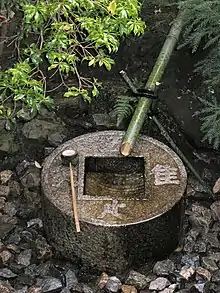Tsukubai
In Japan, a tsukubai (蹲踞) is a washbasin provided at the entrance to a holy place for visitors to purify themselves by the ritual washing of hands and rinsing of the mouth.[1] This type of ritual cleansing is the custom for guests attending a tea ceremony[1] or visiting the grounds of a Buddhist temple.[2] The name originates from the verb tsukubau meaning "to crouch"[3] or "to bow down", an act of humility.[2] Guests attending a tea ceremony crouch and wash their hands in a tsukubai set in the tea garden before entering the tearoom.[3]


Tsukubai are usually of stone, and are often provided with a small ladle, ready for use.[3] A supply of water may be provided via a bamboo pipe[3] called a kakei.
The famous tsukubai shown here stands in the grounds of the Ryōan-ji temple in Kyoto, and was donated by the feudal lord Tokugawa Mitsukuni.[4] The kanji written on the surface of the stone are without significance when read alone. If each is read in combination with 口 (kuchi) - the shape of the central bowl - then the characters become 吾, 唯, 足, 知 which translates literally as "I only know plenty" (吾 = ware = I, 唯 = tada = only, 足 = taru = plenty, 知 = shiru = know).[5] The underlying meaning, variously translated as "what one has is all one needs",[5] or "learn only to be content"[4] reflects the basic anti-materialistic teachings of Buddhism.
See also
- Shishi-odoshi (deer-scarer)
- Suikinkutsu (a musical cave to drain handwashing water)
- Ritual purification
References
- Must See in Kyoto. Kyoto: Japan Travel Bureau, Inc. 1991. p. 107. ISBN 4-533-00528-4.
- Einarsen, John (2004). Zen and Kyoto. Kyoto: Uniplan Co, Inc. p. 133. ISBN 4-89704-202-X.
- Setsuko, Kojima; Crane, Gene A (1991). Dictionary of Japanese Culture (1st American ed.). Union City, CA: Heian. pp. 369–70. ISBN 0893463361. OCLC 23738000.
- Einarsen, John (2004). Zen and Kyoto. Kyoto: Uniplan Co, Inc. pp. 90–91. ISBN 4-89704-202-X.
- "Tsukubai and Zenibachi, the Japanese Water Basins". Retrieved 3 March 2016.
External links
| Wikimedia Commons has media related to Tsukubai. |
- Tsukubai Design & Construction - Tea instructor Elliot Mitchnick discusses the design and construction of the Tsukubai arrangement. (in English)
